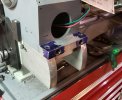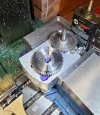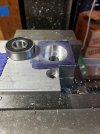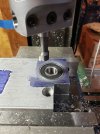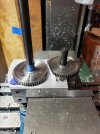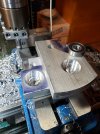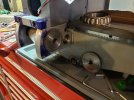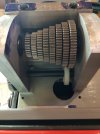Ian
Notorious member
I wanted a little bit bigger lathe and have plans to do something a little different with my old faithful Grizzly 7x14, so I bought one of the cheeeeeeaaaap Chinese benchtop lathes from a fleabay vendor. They'd gotten down to around $1200 shipped for an 8.7x29.5", 1.5 HP model having a 38mm spindle bore and belt drive. Problems are many, among them being they are all metric and have very limited threading capability (2.0mm per turn leadscrew, no thread dial, and an oddball 56-tooth spindle gear driving the change gears). I figured I'd have to do some milling and scraping and a lot of disassembly and cleanup with precision stones no matter what brand I bought so might as well get the cheapest one I could new and not have to deal with worn out and half-broken old South Bend or Atlas hobby machines and their limitations (mainly tiny spindle bore). The other option is buy a PM 11-30V for $4,000 delivered and then have to buy a bunch of new tooling for the bigger tailstock, tune up the whole thing, and be not all that much further ahead than what I ended up doing for about $2,500 less.
Well, I learned a lot. First off, the super-cheap no-name Chinese lathes are made from reject and scrap parts that didn't make the quality cut for the big name importers. Second, I decided to turn this into a REAL project which involves what I'm about to outline.
Step the first was check the bed for flat and straight to see if I had something to work with before choosing my option to send it back. It looked good so I tore it all apart and went to cleaning and fixing stuff like the bottom lips of the ways which were machined so poorly that it was impossible to adjust the carriage to be snug to the bed. I cleaned about a double handful of petrobond, paint, and flashing out of the innards of the bed, cleaned up the body work, primed, and repainted the whole bed. Then I set it up in my milling machine and trued up the underside of both ways. After that I scraped those surfaces in by hand to get less than .0003" total thickness variation for the entire length of 30". This took three setups per side and about 8 hours of tramming.
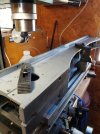
After that, I checked the saddle for being level to the bed and of course it wasn't, so I re-cut the vee-way guide and trued all the major surfaces to the cross-slide ways in one setup on my South Bend 7" shaper.
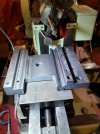
Next I scraped in the the saddle, shaped off the top of the apron to line up with the leadscrew again, and put the headstock back on to check its alignment. I was getting just about perfect vertical alignment and about a thousandth twist over 8" by making two small, very light cuts on an unsupported aluminum rod. Good enough.
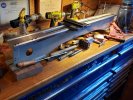
Next was to figure out how to make this thing cut imperial threads with zero error. This turned into a rabbit hole of epic proportions because of the 56-tooth spindle gear and lack of a reverse feature for the leadscrew. Building a quick-change gearbox, a reversing tumbler, and a new banjo system to provide both reverse and arithmetically correct leadscrew drive for imperial threads as well as something smaller than a .0065" minimum feed rate for decent finishes is the only practical way to pull this off. Changing the leadscrew to imperial threads and re-threading the half nuts is also required.
Then I decided to pull apart the spindle and replace the sealed bearings with tapered roller bearings. To my surprise, this thing had a sealed bearing on the outboard side and a single, tapered roller bearing on the inboard side behind the chuck, WTF???? Grease sucks so I'm also going to install real seals instead of sheet metal shields for the bearings and run them in light oil. I polished the inboard spindle journal to be a 57mm sealing surface (it takes a lathe to make a lathe!)
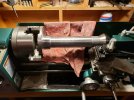
After spending quite a few evenings figuring out gear tooth count, ratios, feeds, and what gears were available, I bought two sets of metal change gears and started work. I got the tumbler and banjo spacing, gearing, and arithmetic sorted out (I think) and a 16 TPI RH 36" leadscrew and 12mm keyed shaft sourced from McMaster-Carr. Bearings and bushings courtesy of Jeff's Dollarama.
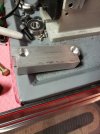
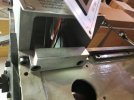
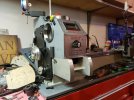
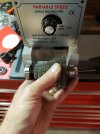
The list:
Well, I learned a lot. First off, the super-cheap no-name Chinese lathes are made from reject and scrap parts that didn't make the quality cut for the big name importers. Second, I decided to turn this into a REAL project which involves what I'm about to outline.
Step the first was check the bed for flat and straight to see if I had something to work with before choosing my option to send it back. It looked good so I tore it all apart and went to cleaning and fixing stuff like the bottom lips of the ways which were machined so poorly that it was impossible to adjust the carriage to be snug to the bed. I cleaned about a double handful of petrobond, paint, and flashing out of the innards of the bed, cleaned up the body work, primed, and repainted the whole bed. Then I set it up in my milling machine and trued up the underside of both ways. After that I scraped those surfaces in by hand to get less than .0003" total thickness variation for the entire length of 30". This took three setups per side and about 8 hours of tramming.

After that, I checked the saddle for being level to the bed and of course it wasn't, so I re-cut the vee-way guide and trued all the major surfaces to the cross-slide ways in one setup on my South Bend 7" shaper.

Next I scraped in the the saddle, shaped off the top of the apron to line up with the leadscrew again, and put the headstock back on to check its alignment. I was getting just about perfect vertical alignment and about a thousandth twist over 8" by making two small, very light cuts on an unsupported aluminum rod. Good enough.

Next was to figure out how to make this thing cut imperial threads with zero error. This turned into a rabbit hole of epic proportions because of the 56-tooth spindle gear and lack of a reverse feature for the leadscrew. Building a quick-change gearbox, a reversing tumbler, and a new banjo system to provide both reverse and arithmetically correct leadscrew drive for imperial threads as well as something smaller than a .0065" minimum feed rate for decent finishes is the only practical way to pull this off. Changing the leadscrew to imperial threads and re-threading the half nuts is also required.
Then I decided to pull apart the spindle and replace the sealed bearings with tapered roller bearings. To my surprise, this thing had a sealed bearing on the outboard side and a single, tapered roller bearing on the inboard side behind the chuck, WTF???? Grease sucks so I'm also going to install real seals instead of sheet metal shields for the bearings and run them in light oil. I polished the inboard spindle journal to be a 57mm sealing surface (it takes a lathe to make a lathe!)

After spending quite a few evenings figuring out gear tooth count, ratios, feeds, and what gears were available, I bought two sets of metal change gears and started work. I got the tumbler and banjo spacing, gearing, and arithmetic sorted out (I think) and a 16 TPI RH 36" leadscrew and 12mm keyed shaft sourced from McMaster-Carr. Bearings and bushings courtesy of Jeff's Dollarama.




The list:
Make a quick change gearbox housing, bore for bearings, install gears and shafts.Done 7/23- Make quick-change sliding lever and install bushings, sliding gear, idler gear, and shaft.
Make seal plates for both ends of the headstock, source seals, and install spindle with new tapered roller bearings.Done 7/24Bore and cut keyway in a 60-tooth gear for the spindle.Done 7/24Make spindle gear spacersDone 7/24 and re-locate spindle speed sensor and magnets.- Make and install stud gear stud on left side of headstock.
- Make tumbler, lever, and detents, tumbler gear studs, and install tumbler assembly.
- Make stud gear shaft.
Make banjo stud/bearing housing.Done 7/21- Make banjo.
Turn, key, and thread ends of new 3/4x16 Acme leadscrew.DONE 7-16-22Fixture, bore, and thread half nuts to 3/4x16 Acme.DONE 7-16-22- Install all parts and make inboard leadscrew drive gear cover.
- Rebuild the belt drive system and maybe install a third belt and reduction pulley.
- Fix or replace the tailstock, it's pathetic, no way to make anything precise with it. Maybe convert it to imperial and replace dial.
- Make new leadscrew and dial for the cross slide.
- Make metric conversion dial for the compound slide.
- Replace the lantern post with an Aloris-style QCTP.
- Buy and fit a 4-jaw chuck.
- Make an outboard spider.
- Put roller bearing tips on the steady and compound rests.
- Make an MT5x5C collet holder and drawbar system.
- Make an 8" face plate.
- Make STUFF!
Last edited:

